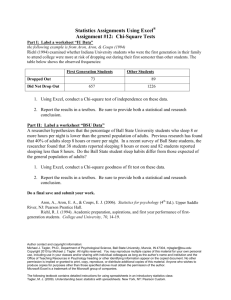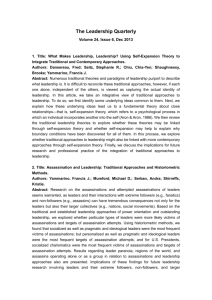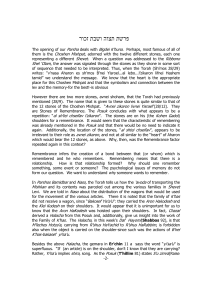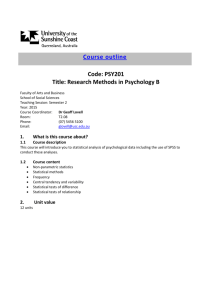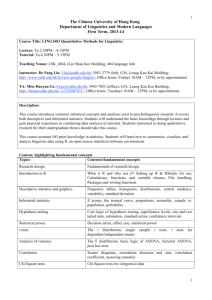Self-Expansion and its Implications for Heath Behaviors and
advertisement
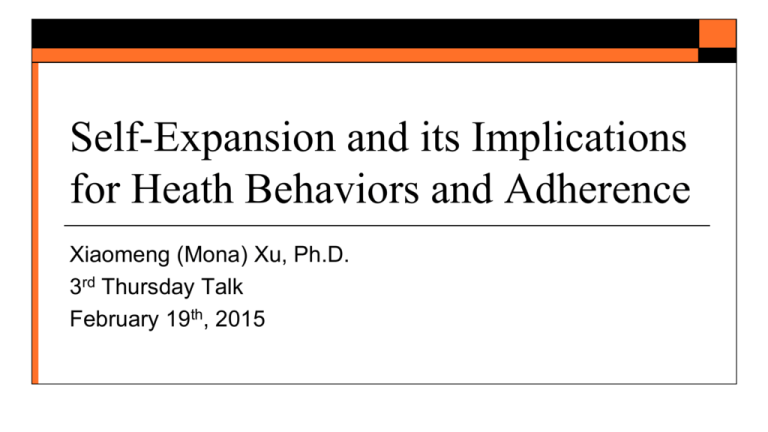
Self-Expansion and its Implications for Heath Behaviors and Adherence Xiaomeng (Mona) Xu, Ph.D. 3rd Thursday Talk February 19th, 2015 What is Self-Expansion? Self-Expansion Model (Aron & Aron, 1986): One of the main intrinsic human motivations is to “expand the self” by attaining resources, perspectives, and identities that facilitate accomplishing goals Experiences that expand a person’s sense of self are characterized by novelty, excitement, interest and/or challenge (subjective) Self-expansion is typically experienced as rewarding and often accompanied by positive affect (although this is not necessary) Love as self-expansion Self-expansion motivation is one reason why we pursue (and maintain) social relationships, experiences etc. Falling in love is a rapid and intense form of self-expansion Relationship initiation and maintenance can be highly rewarding because of excitement, novelty, and interest/challenge of self-expansion Inclusion of other in the self Increases to self-concept What does love self-expansion look like in the brain? Aron et al. (2005) first fMRI study of early-stage passionate love Xu et al. (2011) replication and first fMRI study of early-stage passionate love in a non-Western culture Xu et al: 18 Han Chinese students (10 women) from Beijing. Xu et al. Age: 19-25 years old (M = 21.6) Aron et al had 17 students (10 women) from Stony Brook Aron et al. Age: 18-26 (M = 20.6) Xu et al. Relationship length: 1 - 13 months (M = 6.6 months) Aron et al.: 1-17 months (M = 7.4 months) In-scanner Stimuli 8690 7962 Beloved (30s) Countback (40s) Neutral (30s) Countback (20s) Sample block (2 minutes) Study had 6 blocks (total of 12 minutes) Order counterbalanced Aron et al. vs. Xu et al. VTA activation A: Beloved – Neutral (Aron et al.) B: Beloved – Avg. Countbacks (Aron et al.) Aron, Fisher, Mashek, Strong, Li, & Brown, 2005, Journal of Neurophysiology C: Beloved – Neutral (Xu et al.) C L D L D: Beloved – Avg. Countbacks (Xu et al.) Xu, Aron, Brown, Cao, Feng, & Weng, 2011; Human Brain Mapping VTA VTA Gender universality & Sexuality universality as well: Zeki & Romaya, 2010 PLoS ONE Functions of VTA/caudate Dopamine-rich areas VTA and caudate play a major role in reward and motivation in mammalian brain (demonstrated by electrophysiological, lesion, fMRI, drug infusion, & self-stimulation studies) VTA is involved in all drugs of abuse Self-expansion and addiction Dopamine-rich reward/motivation regions of the brain associated with love self-expansion overlap with those associated with addiction (e.g. nicotine, cocaine etc) Can self-expansion reward replace for substance reward? Self-expansion might be particularly helpful because in addition to being rewarding, it’s linked to reductions in pain perception (Younger et al., 2010) Self-expansion in smoking abstinence and cessation 2 websurveys, community samples: 74 current smokers with at least 1 serious quit attempt min cigs/day = 10 (M = 15.5) mean age was 29.59 years (SD=12.45, 18-78) # days best quit attempt (M = 202, SD = 430) 66 ex-smokers min cigs/day when smoking = 10 (M = 13.07) mean age 23.18 (SD = 7.42, 17-56) # days since last cigarette (M = 708, SD = 1048) Self-expansion in smoking abstinence and cessation Participants reported on the 2 months leading up to their most successful quit attempt Checklist of 49 potentially self-expanding experiences, adopted from Life Experiences Survey (Sarason, Johnson, & Siegel, 1978) E.g. Taking a trip, making a new friend, having an important spiritual experience etc. Self-expansion in smoking abstinence and cessation Ex-smokers experienced more self-expanding events prior to their (successful) quit attempt 5 4 3 *** Ex-smokers Current smokers 2 1 ***p<.001 0 # of self-expanding events prior to quit attempt Xu, Floyd, Westmaas, & Aron, 2010. Addictive Behaviors. Self-expansion in smoking abstinence and cessation Even among current smokers (whose quit attempts ultimately failed): number of self-expanding events positively correlated with length of abstinence: r=0.39, p=0.001 Potential for future intervention What is the mechanism? Xu, Floyd, Westmaas, & Aron, 2010. Addictive Behaviors. Self-expansion and cue-reactivity Does self-expansion influence cue-reactivity among overnight abstinent smokers? Dissertation fMRI studies: Study 1: using early-stage romantic love paradigm Study 2: community sample, longer term relationships, experimentally manipulating non-love self-expansion (cooperative video game) Study 1: early-stage love and smoking 18 male smokers in Beijing in the early stage of a relationship and intensely in love with a non-smoker. Provided pictures of beloved & neutral acquaintance (same sex as beloved) Abstained from smoking overnight (verified CO ppm measures) Same paradigm as love studies but addition of object image next to face image Region of Interest Analyses Analyses targeting regions relating to cigarette cue-reactivity and reward: Main effect in caudate for partner conditions Interaction in Posterior Cingulate Cortex (PCC): Less activation when viewing cigarette cue next to partner (vs acquaintance) Xu, Wang, Lei, Aron, Westmaas, & Weng, 2012 PLoS ONE Study 2: long term relationships and self-expansion 20 Long Island smokers (community sample, in relationship at least 2 years). Abstained from smoking overnight (verified CO measure) While in scanner, played blocks of a two-player cooperative game (partner played outside scanner on computer). Game: 2 (SE or not) x 2 (cig cue or not) SE conditions: more novel, challenging, and exciting (Non SE conditions were rated as equally pleasant) Condition examples SE & Cig cue SE & no cig cue Condition examples No SE & Cig cue NSE & no cig cue Study 2: Region of interest analyses Using cigarette cue-reactivity regions from Kuhn & Gallinat, 2011 meta-analysis: ventral striatum; anterior cingulate cortex (ACC); amygdala; temporoparietal junction (TPJ) Additional ROI: caudate Study 2: Results Main effect of self-expansion on caudate activation (p = .001) Comparing caudate activation in SE conditions vs No SE conditions Interaction effect of self-expansion and cigarette cue in the TPJ (p = .032) and marginally in amygdala (p = .099) such that there was less activation in these regions during SE & Cig conditions than No SE & Cig conditions Xu, Aron, Westmaas, Wang, & Sweet (2014) PLoS ONE Study 2 results con’t Furthermore, activation in TPJ was correlated with excitement of SE conditions above and beyond NSE conditions (r = -.61, p = .012) Self-expansion at the individual level Self-expansion also occurs outside of relationships Current research on increases in self-concept size, self-esteem/selfefficacy, motivation, effort, and consequences in the workplace etc. Because it is rooted in approach motivation (Mattingly, McIntyre, & Lewandowski, 2012), self-expansion leads to increased effort and persistence on subsequent tasks (Mattingly & Lewandowski, 2012) Self-expansion and weight control Shape Up Rhode Island (SURI) 2012 Warren Alpert Medical School, Brown University & The Miriam Hospital 12-week internet based state-wide campaign Join teams that compete on steps, exercise, and weight loss Participants receive pedometer, access to a reporting website, weekly newsletters Campaign increases steps and weight-loss, potentially selfexpanding experience SURI 2012 research study 268 participants (BMI ≥25) who received: Weight Loss 101, given calorie and activity guide Research website for additional monitoring along with 12 online video lessons recorded by experts Lessons based on Diabetes Prevention Program (topics included selfmonitoring, reducing dietary fat intake, problem solving, stimulus control) Is self-expansion associated with better adherence and outcomes? SURI 2012 research study Weight and height measured at baseline, weight was re-measured at 12-weeks (89% retention; N = 239) Adherence measures: frequency of logins and viewing videos, frequency of self-monitoring on website Self-expansion composite at baseline and12-weeks: “How much do you feel like you’ve grown as a person over the past 12 weeks?” (0– 6) “Over the past 12 weeks, how _____ has your life been?” Exciting, boring (reverse coded), interesting (0-6) Self-expansion and SURI 2012 No differences on baseline self-expansion by BMI or other demographics SE significantly increased over the course of the 12 weeks; paired t = 6.55 (238), p <.001 Self-expansion assessed at 12-weeks (controlling for baseline SE) was significantly correlated with % Weight Loss (WL) pr = .16, p = .015 Self-expansion and SURI 2012 SE and reaching clinically significant 5% WL SE assessed at 12-weeks 6 5 **p = .002 4 3 2 1 0 Reached 5% WL Did not reach 5% WL Self-expansion and SURI 2012 Self-expansion associated with self-monitoring adherence: Self-expansion and physical activity in SURI 2012 At baseline and post-treatment, participants completed the Paffenbarger Physical Activity Questionnaire (Paffenbarger, Wing, & Hyde, 1978) Assesses minutes of physical activity over the prior week Baseline self-expansion was significantly positively correlated with total baseline activity minutes r(239) = .11, p = .048. Post-intervention self-expansion was significantly positively related to total post-intervention activity minutes r(239) = .21, p <.001. Remained significant if control for baseline activity minutes pr (236) = .21, p <.001 Fitbit Study (MW CTR-IN pilot study) Self-expansion is associated with greater self-reported physical activity (PA). What about objectively measured PA? What does this look like on a daily basis? SURI 2012 measured self-expansion only at 2 timepoints, 12 weeks apart. How does the link between self-expansion and PA function? Sequentially? In parallel? Bidirectionally? Lagged? General self-expansion seems to be linked with PA. What about PA-specific self-expansion? Fitbit Study (MW CTR-IN pilot study) 50 community participants from Pocatello & surrounding areas Baseline assessment including weight and height and multiple questionnaires (self-expansion, physical activity etc.) Wear a Fitbit One physical activity monitor for 4 weeks Complete daily questionnaires for 4 weeks (including SE questions both global and specific to PA) Follow-up assessment Fitbit Study (MW CTR-IN pilot study) Wave 1 (N = 10) in November-December Wave 2 (N = 40) Feb-March 9 out of 10 participants wore their Fitbit on all 28 days (the final participant wore it for 25 out of 28 days) Participants completing an average of 27.4 days of questionnaires out of the 28 days (97.86% adherence) Currently ongoing! Data will inform an R21 application to test feasibility of selfexpansion intervention to increase PA Self-expansion and health implications Self-expansion plays an important role in health behaviors & may be especially fruitful for informing interventions: People are intrinsically motivated to seek out self-expansion Self-expansion is naturally-occurring and can be easily personalized Because it is linked with approach motivation, increased effort, and is often rewarding, may increase compliance and adherence Does not require equipment, drugs, or medical staff Potentially cost-effective and able to be disseminated to rural and low SES areas Acknowledgements: Funding Mountain West Clinical Translational Research – Infrastructure Network (MW CTR-IN) Pilot Grant [National Institute of General Medical Sciences (NIGMS), NIH] Idaho State University Startup Funds & College of Arts & Letters Course Release program 2T32HL076134-06 (Postdoc Training Grant) from NHLBI F31DA024941-01A2 (NRSA) from NIDA APA dissertation research award APF/COGDOP graduate research scholarship Stony Brook University Psychology dept. retirees’ dissertation fellowship ******************************************* BCS-0937559 from NSF (PI: Arthur Aron) R18 DK083248-01A1 from NIDDK (PI: Rena Wing) 1U01CA150387-01 from NCI (PI: Rena Wing) P50CA084719-080002 from NCI (PI: Lawrence Sweet) R01HL084178-01A1 from NHLBI (PI: Sweet) Acknowledgements: Collaborators & Students Naomi Adams (Idaho State University) Arthur Aron (Stony Brook University) Katherine Boguszewski (University of Virginia) Lucy Brown (Einstein College of Medicine, Yeshiva University) Guikang Cao (Southwest University) Danielle Correll* (Idaho State University) Tingyong Feng (Southwest University) Anna Floyd (Regis University) Grant Harville (Idaho State University) Tricia Leahey (University of Connecticut) Wei Lei (Chinese Academy of Sciences) Ashley Miller* (Idaho State University) Kimberly Kent (The Miriam Hospital) Andrew Seiden (The Miriam Hospital) Lawrence Sweet (University of Georgia) Rick Tivis (Idaho State University) Samantha Tupy* (Idaho State University) Jessica Unick (Alpert Medical School, Brown University) Jin Wang (Chinese Academy of Sciences) Xuchu Weng (Chinese Academy of Sciences) J. Lee Westmaas (American Cancer Society) Rena Wing (Alpert Medical School, Brown University) Thank you! Questions? Comments? Xiaomeng (Mona) Xu: XuXiao@ISU.edu Lab Website: http://xulabisu.weebly.com/

